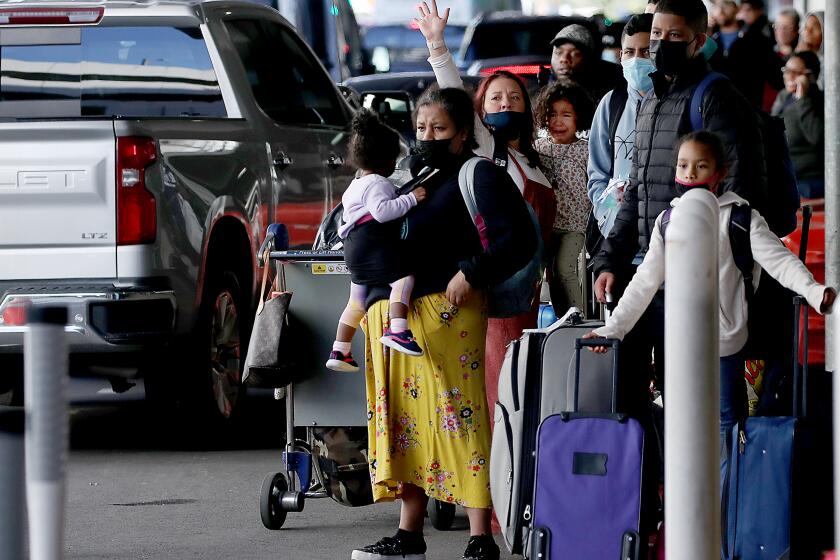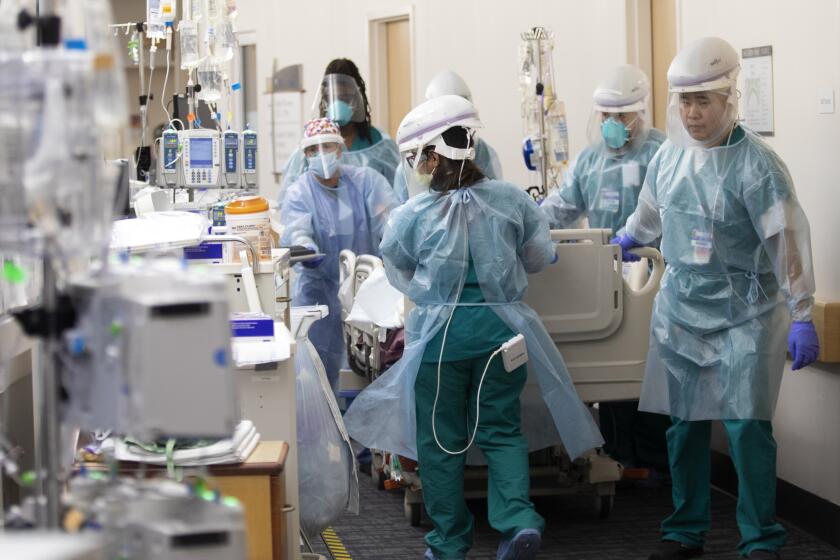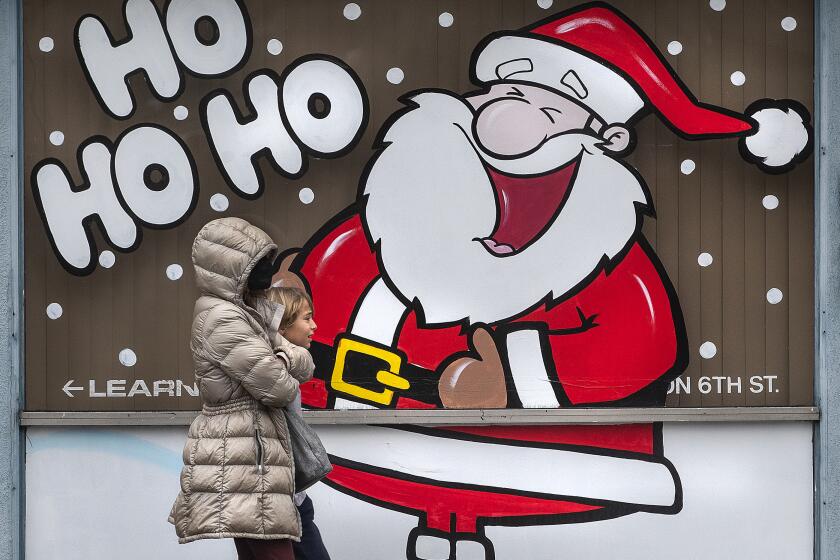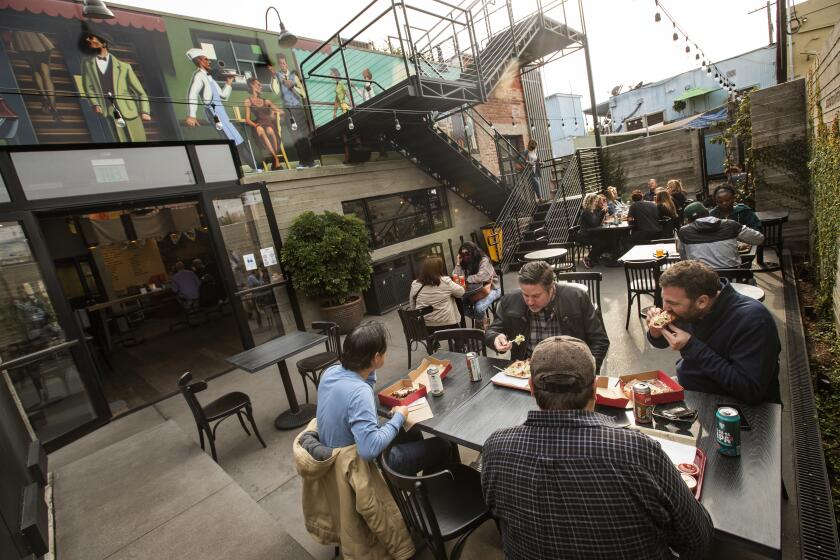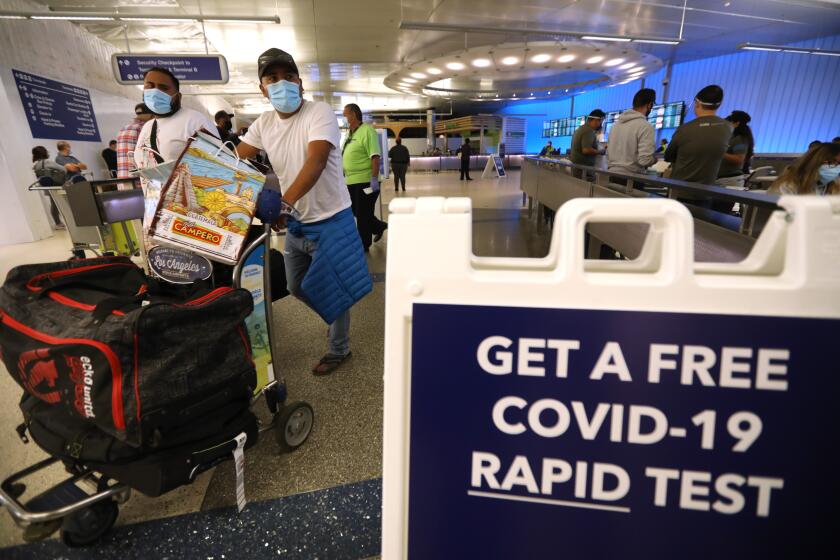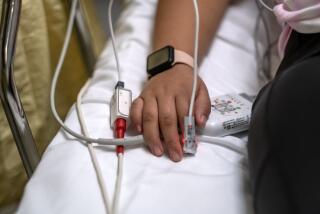Omicron propels a dramatic spike in COVID cases across California; hospitalizations rise
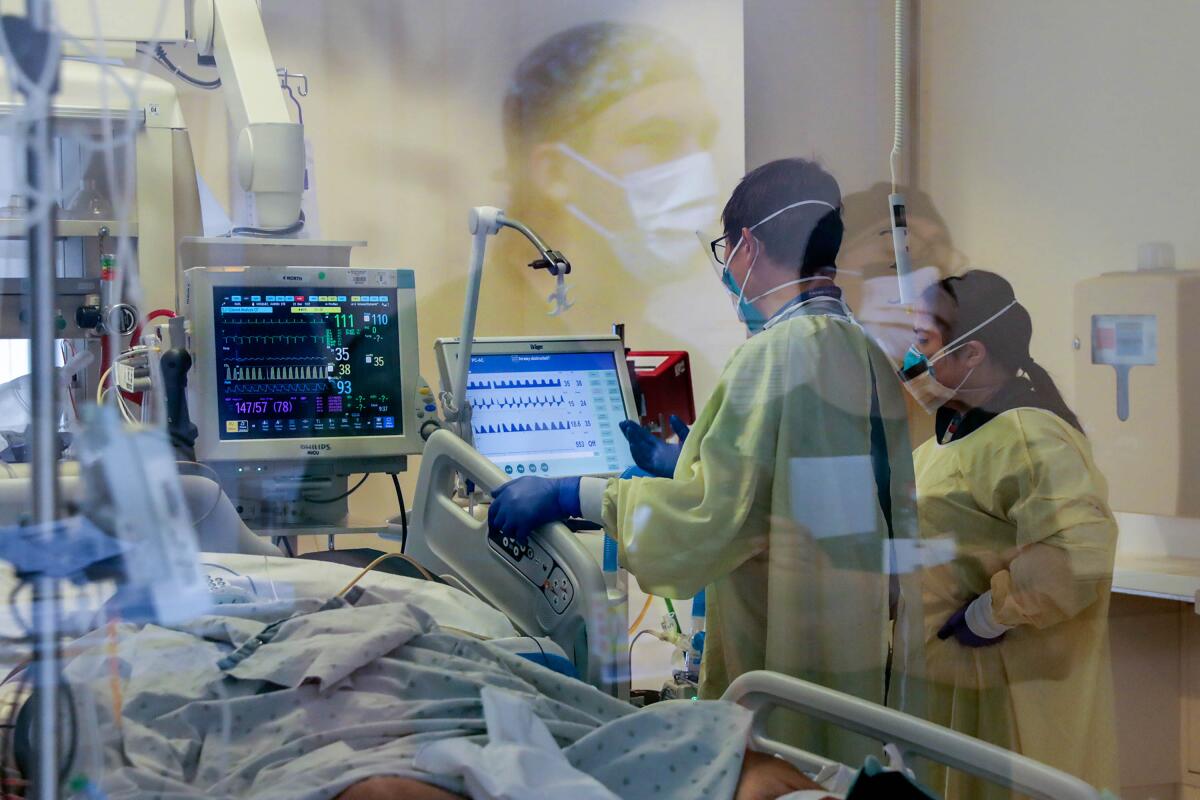
- Share via
An explosion of new coronavirus cases fueled by the rapidly spreading Omicron variant has triggered a sharp uptick in COVID-19 hospitalizations across California, prompting renewed warnings and calls for caution from public health officials.
Over the weeklong period ending Sunday, California reported an average of 11,914 new coronavirus cases per day — a 73% jump from two weeks ago, according to data compiled by The Times.
And that influx of infections is starting to take its toll on hospitals. There were 4,001 coronavirus-positive patients hospitalized statewide on Sunday, a nearly 14% increase in one week. COVID-19 hospitalizations haven’t been this high since early October.
The recent metrics “make it crystal clear that we are heading into very challenging times over the winter holidays,” said Los Angeles County Public Health Director Barbara Ferrer.
“While many will be protected against the most severe illness from Omicron because they are fully vaccinated and boosted where eligible, very high case numbers can easily cause significant stress to the healthcare system if even a small percentage of those infected require hospital care,” she said in a recent statement.
The newest coronavirus case figure is a significant increase from early last week, when officials on Monday reported 3,258 new cases.
Cases spiking
In L.A. County, new coronavirus cases dramatically increased in the lead-up to Christmas.
On Tuesday, 3,052 new cases were reported; on Wednesday, 6,509; Thursday, 8,633; Friday, 9,988; Saturday, 11,930; and Sunday, 8,891. And officials warned that those eye-popping counts over the weekend are actually an undercount because of delays in reporting over the holiday.
At its peak during last winter’s surge, L.A. County was averaging about 16,000 new coronavirus cases a day. But the latest wave could easily top that, Ferrer said.
“If our case numbers continue to increase at a rapid pace over this next week, we could be looking at case numbers we have never seen before — well over 20,000 cases a day by the end of this year,” she said Wednesday.
The percentage of coronavirus tests in Los Angeles County coming back positive has risen dramatically. For the seven-day period that ended Sunday, 10.8% of coronavirus tests had positive results. By comparison, for the seven-day period that ended on Dec. 20, 3.4% of tests returned positive results.
According to data released Thursday by the California Department of Public Health, at least three state health systems have reported that Omicron appears to account for 50% to 70% of new cases.
In metro New York, half of the children being admitted to hospitals are younger than 5 and ineligible for vaccination. California health officials see this as a warning to get more children vaccinated.
Hospitalizations
Los Angeles County’s COVID-19 hospitalizations have also increased significantly since Dec. 1, from 569 to 904 on Christmas Day, an increase of 59%. Hospitalizations spiked further Sunday, to 966.
But the latest number is far below what it was a year ago, when vaccinations had just been introduced and were in sharply limited supply. On Christmas Day 2020, there were 6,815 people with COVID-19 in L.A. County’s hospitals, up from 2,572 on Dec. 1, 2020. At its peak on Jan. 5, L.A. County logged 8,098 COVID-19 hospitalizations, a time that coincided with overwhelmed hospitals and overflowing morgues.
Currently, Southern California’s COVID-19 hospitalizations are increasing faster than the San Francisco Bay Area’s.
Since Dec. 1, the hospitalization rate in Southern California has risen by about 41%, from 7.7 hospitalizations for every 100,000 residents to 10.8.
By contrast, the Greater San Francisco Bay Area has seen its rate climb by 26%, from 3.8 to 4.8. Experts say it’s cause for concern when the rate is 5 or greater.
The Inland Empire has among the highest COVID-19 hospitalization rates in Southern California; San Bernardino County’s rate is 20, and Riverside County’s is 15. San Diego County’s rate is 11; Los Angeles and Ventura counties, 9; and Orange County, 8.
When the Delta wave began during the summer, the Inland Empire fared far worse in hospitalizations than its coastal neighbors, such as Los Angeles County — and it never recovered.
Some experts are expressing hope that areas with high vaccination and masking rates will not be devastated by a surge in COVID-19 hospitalizations.
Dr. Robert Wachter, chair of the UC San Francisco Department of Medicine, wrote Friday that while coronavirus case rates are rising sharply in San Francisco, hospital numbers remain low.
The bad news, Wachter said, is that Omicron is spreading quickly in San Francisco. The good news is that Omicron appears to lead to milder illness, particularly in vaccinated populations, Wachter wrote on Twitter.
Dr. Anthony Fauci on Sunday told ABC that recent data from Britain show that, in its Omicron wave, a lower percentage of newly infected people are needing hospitalizations.
“Interestingly, the duration of hospital stay was lower, the need for oxygen was lower,” Fauci said on ABC’s “This Week.” Still, because Omicron is causing such a high volume of new infections, the variant could find many more people who haven’t been immunized and could still result in hospitals becoming overwhelmed.
Unvaccinated people “are the most vulnerable ones when you have a virus that is extraordinarily effective in getting to people and infecting them the way Omicron is,” Fauci said in the televised interview. Omicron “might still lead to a lot of hospitalizations in the United States.”
Fauci said on ABC’s “Good Morning America” that the Omicron surge is likely to get worse before it gets better.
Though South Africa’s cases are declining, they’re still going up in Britain, and the U.S. usually lags somewhat behind Britain.
“In other words, what happens there generally happens here a couple to three weeks later,” Fauci said. “The way it’s going up right now — it’s going to get worse before it gets better. That’s for sure. We don’t expect things are going to turn around in a few days to a week. It likely will take much longer than that, but that’s unpredictable.”
Evidence continues to mount that vaccinated people who have received their booster shot, but still get infected, generally have no symptoms or mild symptoms, Fauci said.
But Fauci said he remained concerned about severe illness among people who are not vaccinated.
Fauci said medical officials in South Africa are also seeing more hospitalizations among children infected with the coronavirus, echoing new data out of New York seeing a jump in hospitalizations among children, most of whom are not fully vaccinated.
“That’s one of the reasons why we say … if you have a child from 5 to 11, to please get that child vaccinated to prevent them from getting anything that even resembles a serious illness,” Fauci said.
Cases are expected to spike, but holiday gatherings can be safe, even without masks, if everyone is vaccinated and boosted, Fauci says.
Geographic differences
Wachter said he’d be far less upbeat in areas with lower vaccination rates. San Francisco has one of California’s highest vaccination rates, with 88% of the population having received at least one dose. But other areas of the state have lower rates; L.A. County’s is 76%; Orange County, 75%; Ventura County, 74%; Fresno County, 65%; Riverside County, 64%; San Bernardino County, 60%; and Kern County, 56%.
“I’d be ... far more scared if I wasn’t vaxxed and boosted. The unvaxxed are playing a risky hand,” Wachter wrote.
In San Francisco, Wachter said that still expects a bump in hospitalizations, but it “seems unlikely it’ll be overwhelming here.”
In Los Angeles County, officials have expressed concerns about the rising case numbers.
Ferrer said last week that L.A. County can manage rising case numbers without the hospital system being overwhelmed, if more people get vaccinated and boosted, wear masks in indoor public settings and outdoor crowded areas, and avoid large indoor gatherings.
Overall, the decision on dining out comes down to a personal assessment of risk.
Testing
Amid the ongoing surge, L.A. County officials announced they would take steps to expand testing, effective Friday — such as extending the hours of operation at testing sites across the county, “additional week and weekend dates,” as well as more mobile testing units dispatched to “hard-hit areas.”
The county health department is also relaunching a home test collection program in which residents can request an at-home nasal test swab kit and have it delivered by FedEx within two days.
County health officials said that demand for testing has climbed as residents prepare for holiday celebrations.
“L.A. County residents are doing right by getting tested as a precaution before gathering, if they have been exposed and at the first sign of symptoms,” Dr. Christina Ghaly, director of the county’s Department of Health Services, said in a news release. “We will continue to closely monitor testing needs and adjust capacity as needed in the coming weeks.”
At least 87 flights in or out of LAX were canceled Sunday as holiday travelers tried to get back home.
California is also preparing to provide rapid tests for students in K-12 public schools and expand hours at busy screening sites.
“After our kids have enjoyed the holidays ... we want to make sure they come back in as good a shape as they left, meaning we want to make sure that we are testing our kids and preparing them to come back,” Gov. Gavin Newsom said last week.
Newsom emphasized California’s commitment to keeping schools open for in-person instruction — a pledge reiterated in a joint statement his office released Wednesday morning from education-related organizations including the California State Parent Teacher Assn., California Teachers Assn., SEIU California, the state charter schools association and the California School Boards Assn.
Here is more information on getting tested in specific areas:
Nearly two years into the pandemic, Southern California families navigate another holiday season with COVID-19 touching every aspect of their lives.
Other steps
Seven UC campuses have delayed in-person returns, and all UC and Cal State campuses will require boosters for eligible students.
The state also announced that healthcare workers will be required to get COVID-19 vaccine boosters in hopes of protecting both the medical community and the vulnerable populations they serve.
USC announced Friday that classes will take place remotely for the first week of the next term and that students and staff will be required to show proof of COVID-19 booster shots as soon as they are eligible. USC residence halls will remain open, but all students will need to test negative for COVID before moving into campus housing and before in-person instruction resumes. USC also is delaying its spring new student convocation for about two weeks. It originally was scheduled for Jan. 7.
The university said it would announce deadlines for requiring COVID boosters for students, faculty and staff. UC students also be required to get boosters, though it is up to each site to carry out the mandate. Cal State University also issued a COVID booster mandate for students.
Some cities are taking their own preemptive steps. Oakland has moved to join Los Angeles, San Francisco, West Hollywood and Berkeley in requiring proof of vaccination to patronize indoor restaurants and gyms. And in San Jose, the mayor has said he wants to require all city employees to receive booster shots as a condition of employment and anyone who enters city-owned facilities to do the same.
More to Read
Sign up for Essential California
The most important California stories and recommendations in your inbox every morning.
You may occasionally receive promotional content from the Los Angeles Times.

